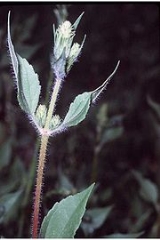
Iva annua
Encyclopedia
Iva annua, sumpweed or marshelder, is an herbaceous
annual plant
native to much of North America
.
in the central eastern United States and specifically the indigenous peoples of the Kansas City Hopewell
culture in present day Missouri
and Illinois
, for its edible seed. As the author Jared Diamond
notes, the edible parts contain 32 percent protein and 45 percent oil.
However, like its relative ragweed
, Diamond notes that sumpweed possesses many objectionable qualities which include being a severe allergen
, possessing "a strong odor objectionable to some people and that handling it can cause skin irritation." For these reasons Diamond believes that it was abandoned once more pleasant alternatives (like corn) were available, and by the time Europeans arrived in the Americas had long disappeared as a crop.
Herbaceous
A herbaceous plant is a plant that has leaves and stems that die down at the end of the growing season to the soil level. They have no persistent woody stem above ground...
annual plant
Annual plant
An annual plant is a plant that usually germinates, flowers, and dies in a year or season. True annuals will only live longer than a year if they are prevented from setting seed...
native to much of North America
North America
North America is a continent wholly within the Northern Hemisphere and almost wholly within the Western Hemisphere. It is also considered a northern subcontinent of the Americas...
.
Uses
Iva annua var. macrocarpa was formerly cultivated by Native AmericansNative Americans in the United States
Native Americans in the United States are the indigenous peoples in North America within the boundaries of the present-day continental United States, parts of Alaska, and the island state of Hawaii. They are composed of numerous, distinct tribes, states, and ethnic groups, many of which survive as...
in the central eastern United States and specifically the indigenous peoples of the Kansas City Hopewell
Kansas City Hopewell
The Kansas City Hopewell were the farthest west regional variation of the Hopewell tradition of the Middle Woodland period . Sites were located in Kansas and Missouri around the mouth of the Kansas River where it enters the Missouri River...
culture in present day Missouri
Missouri
Missouri is a US state located in the Midwestern United States, bordered by Iowa, Illinois, Kentucky, Tennessee, Arkansas, Oklahoma, Kansas and Nebraska. With a 2010 population of 5,988,927, Missouri is the 18th most populous state in the nation and the fifth most populous in the Midwest. It...
and Illinois
Illinois
Illinois is the fifth-most populous state of the United States of America, and is often noted for being a microcosm of the entire country. With Chicago in the northeast, small industrial cities and great agricultural productivity in central and northern Illinois, and natural resources like coal,...
, for its edible seed. As the author Jared Diamond
Jared Diamond
Jared Mason Diamond is an American scientist and author whose work draws from a variety of fields. He is currently Professor of Geography and Physiology at UCLA...
notes, the edible parts contain 32 percent protein and 45 percent oil.
However, like its relative ragweed
Ragweed
Ragweeds are flowering plants in the genus Ambrosia in the sunflower family Asteraceae. Common names include bitterweeds and bloodweeds....
, Diamond notes that sumpweed possesses many objectionable qualities which include being a severe allergen
Allergen
An allergen is any substance that can cause an allergy. In technical terms, an allergen is a non-parasitic antigen capable of stimulating a type-I hypersensitivity reaction in atopic individuals....
, possessing "a strong odor objectionable to some people and that handling it can cause skin irritation." For these reasons Diamond believes that it was abandoned once more pleasant alternatives (like corn) were available, and by the time Europeans arrived in the Americas had long disappeared as a crop.

